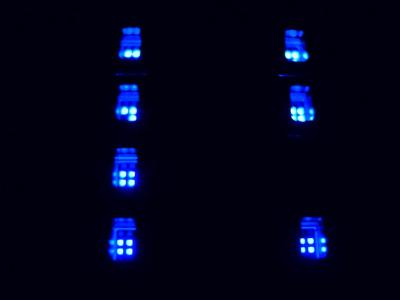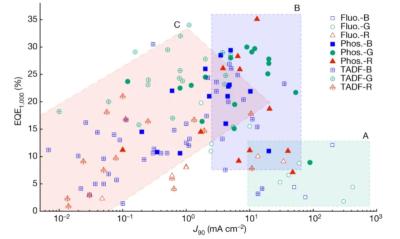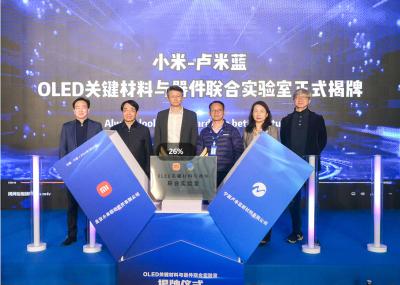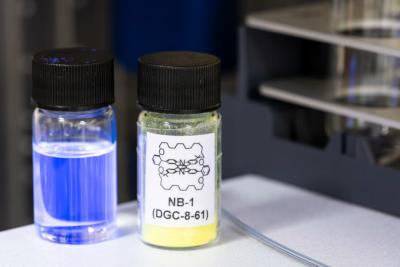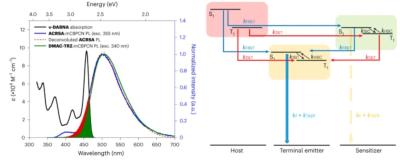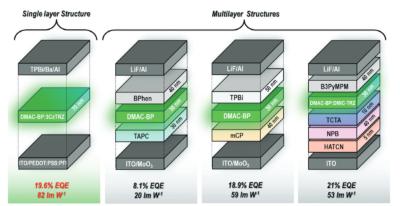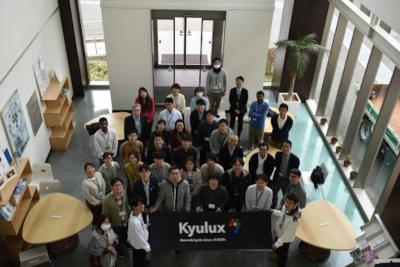TADF OLED emitters, or Thermally Activated Delayed Fluorescence, is a relatively new class of OLED emitter materials that promise efficient and long-lifetime performance without any heavy metals. TADF research started in earnest in 2012, and the first TADF emitters reached commercial status at the end of 2019.
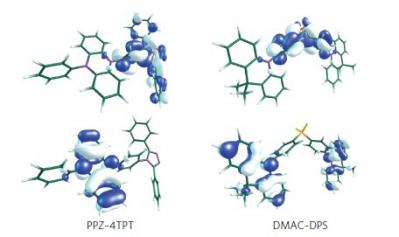
There are currently three main challenges with OLED emitters that TADF aims to solve - an efficient and long-lasting blue color emitter, low cost alternatives current red and green emitters and the development of soluble OLEDs that can be deposited using low cost ink-jet printing or other "wet" methods.
TADF is being developed by several companies. Japan-based Kyulux was established to commercialize Prof. Adachi's HyperFluoresence technology, which combines two emitter systems, TADF and Fluorescence. While a blue HyperFluoresence emitter is not here yet, in late 2019 Kyulux and Wisechip brought to market the first OLED with a yellow HF emitter. Kyulux believes it will be able to commercialize its AMOLED Hyperfluorescence materials by 2025.
Another company involved with TADF development was Germany-based Cynora. In 2022, Cynora was acquired by Samsung. Other companies include Noctiluca, and beeOLED.
Idemitsu Kosan also considers TADF as one of the key OLED technologies and intends to focus on TADF in the future. In late 2019 Idemitsu together with Toray announced the world's most efficient red OLED emitter - based on Idemitsu's TADF/HF material. UDC has been recently awarded a patent on TADF materials, although the company says that TADF is not in its focus.
The EU launched two TADF related collaborative research projects to focus on TADF emitters, Project HyperOLED and the 2015 project Phebe.
Next-generation OLED technologies that will enable brighter and more efficient displays
OLED displays have been gaining popularity rapidly, and are already the dominant smartphone display technology. OLEDs are also the display technology of choice in the smartwatch market, making inroads into the TV, monitor, laptop and tablet markets. The future of the OLED industry looks bright.
In recent years, the focus of the industry, beyond increasing capacity and reducing production costs, has been improving the performance of OLEDs in the areas of display brightness, efficiency, and lifetime. Brightness is required in many applications - from TVs (for HDR and to view in ambient lighting) through smartphones (outdoor viewing) to automotive, and efficiency is a plus in any scenario (but mostly in mobile displays). Display lifetime is already good enough for many applications, but in some cases (like automotive, and IT displays) it is critical. These three properties usually go together - if you can make more efficient OLED displays, you can drive them at a lower current to achieve the same brightness, and so lifetime increases, or you can achieve higher brightness, etc.
Kyulux announces a new CFO as the company progresses towards Hyperfluorescence commercialization
Japan-based Hyperfluorescence materials developer Kyulux announced that Jimyeong Yu will join its executive management team, as the company's new Chief Financial Officer (CFO).
Jimyeong Yu will take over as Kyulux’s CFO, replacing Akira Minakuchi, who passed away in September 2023. As CFO of Kyulux, Jimyeong Yu will oversee financial accounting operations including procurement activities, and as a member of the management team, will be involved in formulating and implementing future business plans.
Researchers develop the longest lasting deep-blue CMA TADF OLED emitters
Researchers from the University of Manchester, University of Cambridge and University of Eastern Finland, led by Dr. Alexander Romanov have developed a new deep-blue Carbene-Metal-Amide (CMA) OLED emitter material with promising operating lifetime.
The emitter is based on a a new CMA complex with a rigid amide donor, benzoguanidine. The researcher say that the new design unlocks bright charge-transfer deep-blue emission with 100% photoluminescence quantum yields. The excited state lifetimes of the new CMA complexes are among the lowest reported to date among all TADF emitters
(down to 213 ns), resulting in remarkably fast radiative rates of up to 4.7 × 10 6 s−1 .
Two research groups show that it is possible to produce a high-performance pure blue MR-TADF OLED emitter without the need for an assistant dopant
Researchers from the Universities of St Andrews, Kyoto and Kyushu have coincidentally developed state-of-the-art multi-resonant TADF (MR-TADF) OLED emitters, based on a helical boron-nitrogen-oxygen doped nanographene design.
In these multiple studies, the researchers have shown that it is possible to obtain deep blue, narrowband emission, very fast reverse intersystem crossing rates constants, and high-efficiency vacuum-deposited OLEDs.
Researchers explain TADF efficiency roll off, to assist material developers in optimizing TADF emitters
Researchers from the University of St. Andrews in the UK, led by Professor Ifor Samuel and Professor Eli Zysman-Colman, identified the key processes controlling the efficiency of TADF OLED emitters under high brightness. This could assist material develops on their quest to design materials that maintain high efficiency at high brightness.
The researchers explain that OLEDs have lower efficiency at higher brightness, and in many TADF materials, the efficiency roll-off is severe, so that the high efficiencies achieved at very low brightness are not maintained at higher brightnesses needed for displays or lighting applications. For the first time, the researcher identified the key processes controlling the triplet population, and propose a figure of merit for efficiency roll-off.
Xiaomi and Lumilan jointly launch an OLED materials R&D project
Xiaomi announced a strategic partnership with Lumilan, an OLED materials developer. Lumilan, with support from Xiaomi, built a new R&D lab in Ningbo, China, to develop new materials targeting smartphone display applications.
Xiaomi aims to get early access (or perhaps exclusive access) to novel OLED material to enhance its competitiveness. It is likely that the two companies aim to develop new OLED stack materials and perhaps new OLED emitters (Lumilan already develops TADF emitters).
UK researchers develop promising new hyperfluorescence blue OLED materials
Researchers from the UK's Northumbria, Cambridge, Imperial and Loughborough universities developed a new Hyperfluorescence OLED emitter system based on a new molecular design, which is highly efficient and simple to produce.
The researchers explain, that in Hyperfluorescence systems, the elimination of the Dexter transfer to terminal emitter triplet states is the key towards OLED efficiency and stability. Current devices rely on high-gap matrices to prevent Dexter transfer, which unfortunately leads to overly complex devices from a fabrication standpoint. The researchers developed a novel molecular design in which ultranarrowband blue emitters are covalently encapsulated by insulating alkylene straps.
Researchers from Durham University use long-forgotten OLED emitter molecules to enable highly efficient hyperfluorescence OLED devices
Researchers Durham University, led by Professor Andrew Monkman, discover new OLED emitters that offer high performance in a hyperfluorescence emission system. The main new material, a molecule called ACRSA, was found to triple the efficiency of hyperfluorescence OLED devices.
These OLED emitters aren't actually new - they were studied years ago, but were found to be poor emitters. That was true when used as OLED emitters, but when used in a hyperfluorescence system (which combines both fluorescent and TADF emitters), these were surprisingly efficient. The ACRSA emits a green emission, but deep blue light emission can be achieved by transferring ACRSA's energy to a blue terminal emitter. This approach reduces exciton energy compared to direct blue emission in devices, allowing more stable, longer-lasting blue OLEDs.
Single-layer TADF OLEDs outperform the best multi-layer device in both efficiency and lifetime
In 2023, we reported on research conducted at Germany's Max Planck Institute, led by Prof. Paul W.M. Blom, that looks into single-layer OLED devices. In such devices, a single TADF OLED emitter layer is sandwiched between two electrode - a much simpler design compared to commercial OLED devices that use multilayer stacks, sometimes with 10 or more layers. The researchers the the MPI say that in fact it is possible to develop highly efficient OLEDs with just the TADF emitter - and have demonstrated 100% IQE single-layer devices, with an EQE of 27.7%.
Prof. Blom's group continues to improve its single-layer TADF OLED device, and have now reported that by employing a recently developed trap-free large band gap material as a host for the DMAC-BP OLED emitter, a nearly balanced charge transport is achieved. The device achieves a record power efficiency for DMAC-BP TADF OLEDs of 82 lm/W - surpassing the best reported multilayer power efficiencies of 52.9–59 lm/W. This is due to the lower operating voltage. The single-layer device reaches an external quantum efficiency (EQE) of 19.6%, which is only slightly lower than the reported EQEs of 18.9–21% for multilayer devices. In addition to the high power efficiency, the operational stability is greatly improved compared to multilayer devices and the use of conventional host materials in combination with DMAC-BP as an emitter.
Kyulux raises $28.6 million, is on track to achieve full-scale mass production of its HF/TADF emitter system by 2025
Kyulux announced that it has raised $28.6 million USD in its Series C funding round, led by El Camino Capital and the MCP Group. This brings Kyulux total funding so far to $86 million USD.
A part of the Kyulux team based in Fukuoka, Japan
Kyulxu says that it will use the newly raised funds to further accelerate its product development, strengthen its IP portfolio and achieve full-scale mass production of its emitter system by 2025, with its affiliated chemical companies.
Pagination
- Page 1
- Next page




